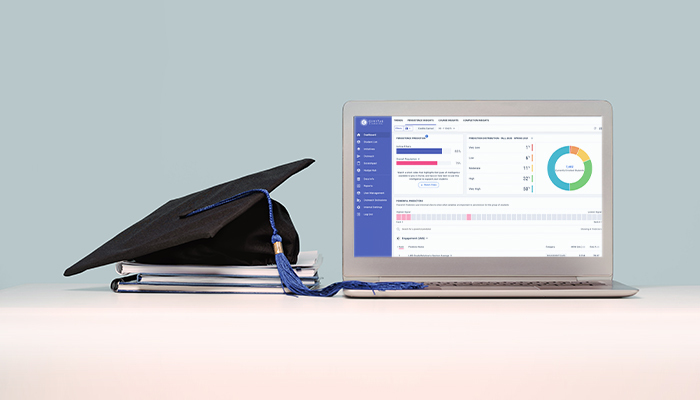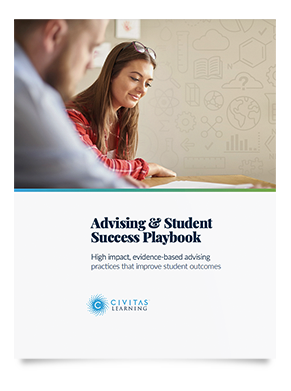
4 Data-Driven Strategies to Scale Student Outreach
Share this Post
Is your student success team serving the right group of students at the right time via the right channel to improve outcomes?
Colleges and universities have many different ways to support students. Still, it can be challenging to identify which students to help and how to intervene in ways that improve their likelihood of success.
One of the challenges we continually hear in conversations with higher education leaders is how difficult it is to scale student success services effectively. Resource constraints coupled with evolving student needs make it difficult to hire enough academic advising and student success staff to tackle an ever-increasing workload.
Hiring more academic advisors or standing up additional student success services may not always be the best way to meet the growing demand for student support.
Advising and Student Success Playbook
4 Ways to Use Student Data to Scale Student Outreach
Here are the top takeaways your advising and student success teams can use to drive more effective and efficient student outreach and communication:
1. Get More Value From Your Existing Student Data
Your institution’s information systems, like SIS, CRM, LMS, and other student records, can provide you and your team with rich and valuable details about a student’s college experience. Civitas Learning® partners can use the Student Impact Platform to pull all of this data into a single source. Then run data through a machine learning framework to generate predictive analytics, which empowers administrators, faculty, and staff to see a holistic view of the student journey.
Your historical student data combined with current SIS and LMS data allow you to identify data points that are highly predictive and create data models for groups of students across your institution. Student success teams gain real-time visibility into the needs of students and can more accurately prescribe appropriate interventions. This ability to translate insights into action improves your ability to help students persist at your institution and achieve their academic goals.
2. Use Predictive Intelligence to Facilitate Targeted Outreach to Student Groups
Predictive analytics provide valuable insights into how students are likely to perform if their current behaviors and situation continue. Predictions are not deterministic. Instead, they are signals that let you know what may occur without intervention.
Persistence predictions help student success teams prescribe accurate interventions when students need them. If an advisor knows whose persistence likelihood declined from last week, they can proactively engage with the student and connect them with the right resources. This allows students to acquire the skills and interventions they need in time to be successful this term. Predictive analytics provide student success teams with the insights they need to prioritize their time and focus to help more students.
3. Create Efficiencies and Improve Efficacy of Student Outreach
Your institution has many different ways to support students, but only so much time and so many people support them. Several of our partners find that students who are least likely to succeed and return next term are also least likely to seek support. Unless strategies and systems are in place to provide proactive outreach, vulnerable students receive services less often. Our partners can use the likelihood to persist produced by the Student Impact Platform to help them prioritize when and how to engage with their students.
Administrators can determine which factors best predict which students will not persist to the following term or not complete their credentials on time. Your ability to know what programs are effective not only for overall persistence but for specific student groups can help your team determine which interventions and engagement are most likely to benefit students.
4. Define a Multi-Channel Communication Strategy
Research tells us that various student populations have very different college experiences and communication expectations. A recent Blackboard survey of 2,100 postsecondary students found that non-traditional students are more likely to prefer text messages than traditional students. Seventy-five percent of today’s college student population is considered “non-traditional.” This diversity in student experience means students have a wide range of communication needs and preferences.
Civitas Learning® partners can use student data to help them determine which channels are the most effective mode of communication for particular students. Advisors can use the Student Impact Platform to send nudges to students with a high likelihood of persistence. They can also use advising workflow tools to schedule meetings for students with moderate persistence predictions to uncover challenges and provide resources. Advisors can utilize SMS functionality to send text messages to connect with students who need immediate support or struggle to engage.
By communicating with students in ways that resonate with them, student success teams can improve the effectiveness and efficiency of their communication efforts, ultimately making a more significant impact.
Use Data Analytics to Help Your Team Work Smarter
Data and intelligence don’t ask you to do more–these insights allow you to know more. They allow you to prioritize your time to engage with students in ways that will benefit them most and make the most of your valuable time and resources.
Leaders can use data analytics to identify populations who may not graduate. Then use insights gleaned from that data to identify factors that contribute to positive outcomes. These insights allow your institution to know how to allocate human and financial resources to the most beneficial initiatives, interventions, and programs.
Meanwhile, predictive analytics helps advisors and student success staff prioritize outreach and engagement with students most in need of support today. The visibility into real-time information provides a holistic understanding of student needs and communication preferences. Data analytics empowers your student success teams to have more effective outreach and focused engagement to improve retention, persistence, and completion for more students.



